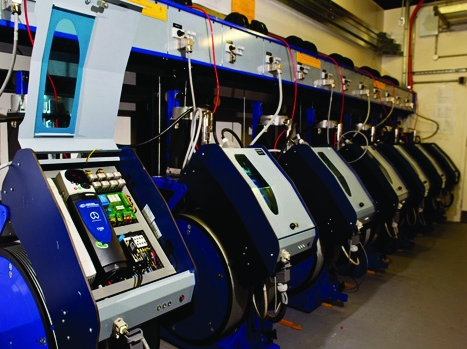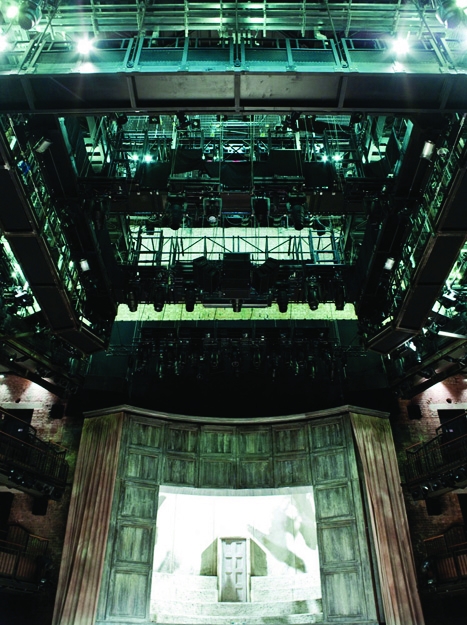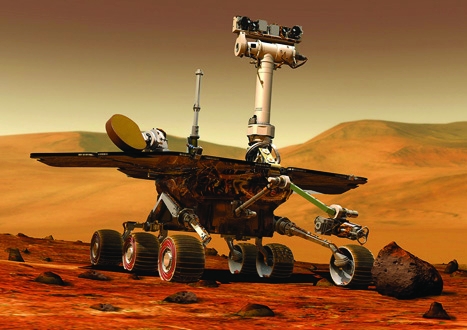When the Royal Shakespeare Company (RSC) decided to renovate its home theatre in Stratford-upon-Avon, it wanted to create an experience for theatre goers that was closer to how Shakespeare’s original audiences would have watched his plays. But building a relatively small stage that thrust out into the audience created some particular problems for those in charge of controlling the scenery and lighting mechanisms.

‘There are two factors at the Royal Shakespeare Theatre that are slightly different from other theatres,’ said Adam Harvey, head of automation at the RSC. ‘One is we’ve got a thrust stage rather than the normal proscenium arch, so that means there doesn’t tend to be big sets and scenery but there might be lots of little bits and pieces flying in and out over the head of the stage.
‘The second thing is that we do shows in rep so we might do a couple of performances and then a two-hour change into another show and then a two-hour change into another show. So whatever sets we have must be quite flexible in terms of how quickly we can change them over.’
The solution the RSC chose was to develop an automated hoist system to lift pieces of scenery onto and off of the stage, using two winches that can be operated together or independently using a single motor - instantly doubling the amount of cables the theatre could attach scenery to. Installing 60 of these motors (and so 120 winch cables) has given the company some of the flexibility it needs to meet the demands of its set designers.
The sine-cosine drive can see even the smallest amount of rotation, and if the load moves the drive can compensate for itEd Evans, Control Techniques
To build the system, the RSC turned to Dutch theatre equipment company Trekwerk, which worked with drive manufacturer Control Techniques - part of Emerson Industrial Automation - to develop not just the hoist technology but also the network that connects and controls all the motors, allowing them to be operated from a central interface.
Each hoist device consists of two winch drums holding steel wire rope that passes through a grid to the stage below. They are connected to a permanent-magnet servomotor via a clutch that can engage either or both of the drums to lower or raise the cables in response to signals from an electronic drive. Attached to the motor is also a feedback device known as a sine-cosine encoder that detects any movement and allows the drive to operate with precise accuracy.
‘With a lower-resolution encoder, you might get one degree of turn before the drive actually notices the motor’s moved,’ said Ed Evans, Control Techniques’ technical training manager. ‘But with the sine-cosine encoder, you can get much higher resolution, so half or third of a degree. The drive can actually see even the smallest amount of rotation, and if the load moves, the drive can compensate for it.’
The difficulty that a two-winch clutch system presents from the theatre’s point of view is that it adds an extra component that has the potential to fail. But with safety, a key requirement of the system since the start, Trekwerk has built in a range of electronic and software-based functions to try to prevent anything from going wrong. Part of the control circuitry is an element known as safe torque-off, which disables the drive output signal to the motor in the event of component failure, while the drums themselves have electromagnetic brakes that engage if the drive trips.

Once the motor is moving, it is constantly monitored for any signs of a problem, said Michiel Moolenaar, manager of Trekwerk’s service and support department. ‘If one of the motors goes wrong or the load is too heavy, then the whole movement stops; you get an error message on the computer and the operator has to do something about it. Everything has to be correct before you can run the system.’
The drives are connected via a communications network called CTNet and a host drive to a central computer built by Trekwerk known as TNM or ‘The New Machine’. This allows the scenery operator to send signals to each winch at the relevant cue in the script, for example raising a cable by 10m in 30 seconds. But most of the actual motion control is determined and managed by the individual drives and their application modules. ‘They use what we call distributed intelligence,’ said Teun van der Heiden, Control Techniques’ account manager. ‘The software controls the drive but also communicates with the host drive to find out if all the other participants in the system are okay. If you have a very heavy thing to lift, maybe you could use three or four of those drives, so it’s important to start and stop in a synchronised way and also have a very good load balance and load sharing between all those drives.’

The motors are powered by direct current through a specially installed power network connected to the alternating current mains supply via an inverter. This allows the devices lowering their cables to regenerate power through the force of gravity that can then be fed into other motors raising their cables at the same time. Trekwerk also developed a bespoke lighting installation for the RSC that again uses motors to raise or lower clusters of lamps, using another set of winches to manage the power cables as the lights go up and down.
The system’s development over the past two-and-a-half years hasn’t been a smooth one, not least because of a fire that destroyed Trekwerk’s prototypes midway through the process. Once the hoists were installed in theatre, the companies had to undergo a six-month period of working out teething problems, largely in the shape of software bugs.
According to Harvey, although the system hasn’t created whole new possibilities for set design, it has made operations faster and more flexible. ‘For example, for a show of A Midsummer Night’s Dream, we had 20 different coloured wooden chairs hung off these winches and they wanted to do a whole movement where they danced in and out. And you can hit a randomise function and they’ll move up and down at different speeds and things like that.’
But there is also more to be done, with the RSC determined to link the system to a multi-functional drive unit that can control a hydraulic scissor lift, pneumatic effects and other server motors, as well as a way to automatically slide mounted scenery panels on and off. The company is even hoping to find a way to enable actors to fly freely in three dimensions across the stage in time for a planned future production.
Direct approach
Aerotech has introduced the CCS series of rotary stages, which utilises direct-drive technology for 24/7 production environments and enables the automated handling of a range of materials. The stages feature an integrated captured collet-chuck design. Mounting features on the housing support customer-supplied wet-cutting accessories, while the stage itself tolerates moderate fluid leakage into the aperture. These features help prevent encoder contamination.
Smooth operations
The 242 series of manual quarter-turn gear operators from Rotork Gears is suitable for the operation of ball, butterfly and plug valves or other quarter-turn devices in general industrial applications. Five sizes are available to accept valve steam diameters of up to 70mm (or 58mm’ section). They deliver an output torque range of up to 2,100Nm.
Project focus
Maxon Motors is hoping to learn from its latest space exploration project: developing landers for use in temperatures of more than 400°C

Maxon Motor is no stranger to interplanetary exploration, having supplied motors to three NASA Mars rovers, as well as the unsuccessful British-led Mars mission Beagle 2. Now, the company is hoping its new space venture will not only bring it prestige and publicity but also help it make inroads into other markets.
‘We’re working with ESA on high-temperature landers for temperatures of more than 400°C, and that’s going to lead back into work we’re doing on the downhole drilling market [in the oil and gas industry],’ said senior sales engineer Ian Bell.
‘We won’t make any money out of the ESA project - it will be cost neutral, hopefully. But we’ll learn and we’ll be able to develop products for the terrestrial market, or certainly the sub-terrestrial market.’
Maxon currently produces motors for oil drilling that can withstand 200°C as they drill through kilometres of rock, but the demand coming from industry is increasing to temperatures of 250°C. The company hopes that, by using the results of its research for ESA to create motors that work at even stronger heats under the exposure of intense solar radiation on other planets, it can futureproof its drilling products for the next 10 years.
The critical factors in developing the motors are material selection and manufacturing techniques, said Bell. ‘For instance, with the motors we’re doing for the interplanetary lander, the magnets that will survive the high temperatures are typically samarium-cobalt, a rare earth.’
This particular material is relatively expensive but can withstand harsher environments than the more common neodymium rare-earth magnets. And using laser welding as opposed to other bonding or press-fitting techniques to join the magnet to the rotor also provides the required robustness.
Bringing cutting-edge space research into products for terrestrial markets will also help deal with growing competition from places such as China, added Bell. ‘Chinese manufacturers are raising their game and they’re plucking the low-hanging fruits from our tree and taking business from us so we’re being pushed further up, and what might have been a market where there wasn’t enough business for us is now really quite attractive.’




Nanogenerator consumes CO2 to generate electricity
Whoopee, they've solved how to keep a light on but not a lot else.